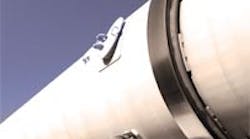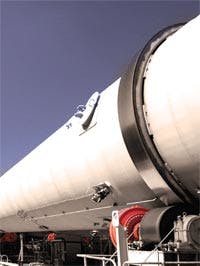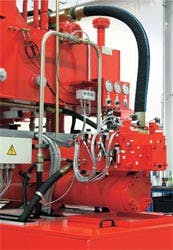The Southern Metropolitan Regional Council’s (SMRC) waste management facility in Perth, Australia has reduced landfill by more than 100, 000 metric tons per year, due in part to a low-speed, high-torque hydraulic drive used on the facility’s digesters. The high-quality compost helps increase the yield of local farms, and the equipment that produces it is the most efficient in Australia. Each year, 5000-6000 guests visit the area for a first-hand look at how it’s done.
But things were not always this good. As recently as 1998, the SMRC was using traditional waste management methods and sending 87% of its domestic waste to landfills. Determined to improve the situation, the council set its sights on state-ofthe- art technology.
SMRC CEO Stuart McCall and other officials travelled the globe in search of advanced reclamation methods for a new waste management facility. Among their discoveries was a novel form of in-vessel composting, which McCall encountered in Atlanta. “The key advantage (of the technique),” offers McCall, “is that it doesn’t rely heavily on people changing their behavior. It turns about 23 of the waste people put into a green bin into compost.”
Initial considerations
Having selected in-vessel composting as the method of choice, the SMRC designed a facility of overwhelming size. In addition to a materials recovery plant for recycling, and a processing plant for green waste, the facility was to feature the second largest in-vessel composting plant anywhere in the world.
A question that remained, however, was how to drive the facility’s four massive digesters. The rotation of the digester shells, each 70-m long and 4.6 m in diameter, would be the critical element for turning raw waste into compost. Ring gears surrounding each digester that could be driven by electromechanical gearmotors were initially considered, but analysis showed that these would be prone to rapid wear.
“The fact that the waste changes volume and density at various stages of its travel through the digesters means the digester shell deflects and does not remain completely straight,” explains Kevin Jones, project manager for the SMRC. “This would create a lot of wear and tear on a conventional ring gear-and-pinion drive because continuous full-face contact would be impossible to achieve.” In other words, a traditional drive system would mean increased downtime and a heavy dependence on spare parts.
Instead, the SMRC chose a less conventional solution using low-speed, high-torque hydraulic motors from Hägglunds Drives AB, Mellansel, Sweden. Instead of gears, each drum is rotated by four pairs of rubber rollers, with two pairs of rollers mounted at each end of each digester. The hydraulic drives do not require the foundations, gearboxes, or clutches needed by electromechanical systems. Not only are the hydraulic drives simpler, but they exhibit a lower moment of inertia and can be run at infinite variations of speed.
Hägglunds delivered 16 hydraulic motors to drive SMRC’s digesters. Each motor drives a rubber tire mounted between a pair of rollers, thereby producing a high friction drive.
Results speak for themselves
Since the facility’s inauguration in 2004, the results have spoken for themselves. The friction-driven trunnion rollers, whose shafts are self-aligning, provide full-face contact that drastically reduces wear and tear. According to project manager Kevin Jones, “Our most recent measurements and predictions indicate that the driven tires will last 194 years!”
Likewise, the Hägglunds solution has protected the facility from unplanned stops in production. The drive system automatically senses load shifts and directs power to the motor that needs it most, so each digester can be operated with as few as two motors. “If one or even two motors are out of service,” says Jones, “production can still continue at a lower throughput. Damage a ring gear, and the digester would be down for months while a replacement was manufactured.”
Effective and efficient
But above all, the drive system has helped the SMRC get the most out of its composting technology. The council expects to maintain plant efficiency at 84% over the long term, compared with an estimated ring-gear drive efficiency of 70% to 75% at best. “Over 20 years,” Jones predicts, “this will account for huge savings in electricity.” Already today, the plant’s energy consumption is 40% less than originally estimated.
Overall, the new facility has achieved a waste recovery rate of 70%, which is nearly 20% better than that of its closest rival. The SMRC has the most efficient waste management in Australia, having reached the facility’s design capacity already in its first full year of operation.
The impressive results have been noticed in Australia and elsewhere, which helps to explain the high number of visitors to the SMRC each year. As word spreads further, McCall is convinced that the facility preswill be copied both nationally and internationally.
Yet even so, the SMRC is far from resting on its laurels. McCall is focused on the future, and has set his sights on a far more difficult target. “We’re proud and happy that we’ve been able to reduce landfills by more than 100,000 tons per year,” he says, “but within the next 20 years, we’re hoping to get rid of landfills altogether.”
Click here for more information on low-speed, high-torque drives, call Hägglunds Drives, a division of Bosch Rexroth.
New life at high pressure
Recycling of waste materials has become the norm — and it is not just limited to metals and paper. Almost all materials, including a variety of plastics, can now be recycled.
Recycling is catching on especially in Europe, where more than 130,000 companies and more than 270 million people are involved in recycling materials. In Germany alone, around five million tons of retail packaging finishes up in yellow bins, bags, and containers. And recycling also benefits Germany’s economy: 17,000 jobs depend on this branch of the economy.
Machine serves the need
Recycling is not only good for the economy, it also conserves resources and reduces environmental impact. One aspect of recycling that is often overlooked is that to gain the greatest environmental impact, the machines involved in the recycling process themselves must be energy efficient. One leader in this sector is Umwelt Nord Technik GmbH & Co. KG (UNoTech), Hohenlockstedt, Germany.
UNoTech developed a channel bale press, which can compress up to 38 tons of material in one hour into spheres while expending minimal energy. The spheres weigh up to 1760 lb each, up to 20% denser than what comparable machines produce. One of the machine’s capabilities that makes this possible is intelligent pressure control.
Recyclable materials are brought into the press by a 45-ft long conveyor. Once the press chamber has been loaded, hydraulic cylinders apply up to 200 tons of force, compressing the material into 200-ton bales ready for shipment. These bales are then automatically tied with wire to keep them from expanding.
Intelligent pressure control
The recyclable material is compressed by transmitting 3625-psi bar of hydraulic pressure. This is accomplished by a complete hydraulic system supplied by Bosch Rexroth. Served by a 925-gal reservoir, variable-displacement pumps incorporate an integral constant-power control. The constant-power control regulates pump displacement to match the load. The precision of these axial-piston hydraulic pumps allows them to closely match output with application requirements. They also operate with relatively low noise generation.
For example, the material is loosely packed at the beginning of the compression cycle. Therefore, minimal compression is needed, so the pumps operate at or near their full displacement. At full displacement, the pumps supply the press cylinders with maximum flow, so they extend at maximum speed. As the air is squeezed out of the material, higher compression force is needed. This causes the constant-power control to reduce pump displacement, so reduced flow (slower extension speed) is traded off for higher hydraulic pressure (compression force).
Klaus Barnitzky, of Bosch Rexroth explained the pressure-flow relationship by analogy: “When you pump up a bicycle tire with air, the work is easy at first. However, as the air in the tire becomes more compressed, it becomes harder and harder to push the pump plunger down until. At some point there would be no point in continuing to push with the same force because you would be wasting too much energy. We applied this same principle in the system for UNoTech — we constantly keep the pressure buildup on the press at a level approaching the maximum.”
The savings are considerable, explained Günter Bielefeldt, Works Manager at UNoTech. “Even if we are only just beginning to identify the exact savings in terms of energy, we can say with certainty at this stage that it is probably more than 25%.” In addition to lower energy consumption, the new pressure system ensures noticeably less wear.
Additional features
From a total cost of ownership view, the system offers considerable potential for savings. Bosch Rexroth also supplied a cus tom cont rol block and the main axle cylinder. Cylinders for additional plant equipment , such as automatic tying equipment, were connected to the control block. This allows a wide range of wire cross-sections to be run without any adjustment work or any retrofitting. This creates adequate safety and reserves for different press items.
The Optimat series offers maximum material throughput and maximum availability, coupled with low wear-and-tear and ease of servicing. Some raw materials recycling operations are already saving a great deal of energy with the Optimat system, at the same time conserving our environment and giving recyclables an extended lifespan.
For more information on Bosch Rexroth pumps, controls, or other products or services, visit www.boschrexroth-us.com or call (800) 739-7684.



